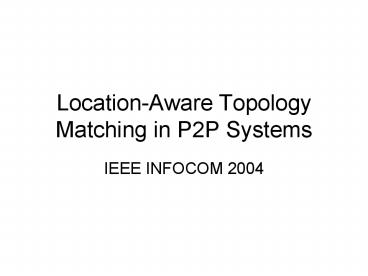LocationAware Topology Matching in P2P Systems - PowerPoint PPT Presentation
1 / 32
Title:
LocationAware Topology Matching in P2P Systems
Description:
Choosing physically closer nodes as logical neighbors. Still retaining the search scope and reducting response time for queries ... – PowerPoint PPT presentation
Number of Views:60
Avg rating:3.0/5.0
Title: LocationAware Topology Matching in P2P Systems
1
Location-Aware Topology Matching in P2P Systems
- IEEE INFOCOM 2004
2
Outline
- Abstract
- Introduction
- Location-aware Topology Matching (LTM)
- Simulation
- Conclusion and Future Work
3
Abstract
- Peers randomly choosing logical neighbor without
any knowledge about underlying physical topology. - Topology mismatching
- P2P overlay network
- Physical underlying network
4
Abstract cont.
- Location-aware topology matching (LTM)
- Disconnecting low productive connections
- Choosing physically closer nodes as logical
neighbors - Still retaining the search scope and reducting
response time for queries - Scalable and completely distributed (does not
require any global knowledge of the whole overlay
network)
5
Mismatching Problem
- The same message may traverse the same physical
link multiple times - Multiple paths that are merged to the same peer
- The same query message may traverse the same
logical link twice
6
Introduction
- Gnutella (Decentralized unstructured P2P)
- Generate 330 TB/month with 50,000 nodes
- Inefficient overlay topology
- Blind flooding
- Location-aware topology matching (LTM) scheme
- Issues a detector in a small region
- Record relative delay information
7
P2P Overlay
8
Unnecessary Traffic
- Unnecessary traffic
- A2 ltgt A3
- B1 ltgt B3
9
Topology Mismatching
10
Three Main Operations of LTM
- TTL2-detector flooding
- Low productive connection cutting
- Source peer probing
11
TTL2-Detector Flooding
12
Low Productive Connection Cutting Case 1
13
Low Productive Connection Cutting Case 2
S
N2
N1
N2P is in Ps Will-Cut List if Time(N2P) gt
Time(SN2),
N1P is in Ps Will-Cut List if Time(N1P) gt
Time(SN2),
P
14
Low Productive Connection Cutting Case 3
- Select
- S lt-gt P
- S lt-gt N1 lt-gt P or
- S lt-gt N2 lt-gt P randomly
15
Source Peer Probing
- Not receive S lt-gt P
- Create a new path
- S-P
- Probing
- Low productive connection cutting
16
An Example of LTM
17
Simulation Setup
- Topology generation
- 5 physical topologies with 22000 nodes
- Overlay networks with 2000 to 8000 nodes
- Avr. Number of neighbors 4 to 10
- Flooding search simulation
- Flooding search with BFS (i.e., Gnutella)
- Dynamic P2P environment
- 0.3 query /min
- Mean lifetime 10 min
18
Simulation Metrics
- Traffic Cost
- consumed BW
- Search Scope
- Number of peers reached
- Average neighbor distance
- Delay time between source and neighbors
- Response time
- query response time
19
Traffic Cost vs. Search Scpoe
- Static environment
- With a given traffic cost, LTM will increase its
search scope
20
Traffic Reduction vs. Optimization Step
- Static environment
- With 8,000 peers
- The traffic cost reduction reaches to a threshold
after 2-3 steps
21
Average Neighbor Distance vs. Optimization Step
- Static environment
- One-step LTM optimization reduces average
neighbor distance by about 55, more steps to
around 65
22
Average Response Time vs. Optimization Step
- Static environment
- LTM can shorten the query response time by about
62
23
Effectiveness of Will-Cut List
- Dynamic environment
- Response loss problem
- The query success rate in dynamic environments is
decreased by about 5 - The query success rate is decreased by 3040
without W-C
24
Effectiveness of Cut List
- Dynamic environment
- The use of the cut list reduces traffic overhead
by about 50
25
Total Traffic vs. LTM Frequency
- Dynamic environment
- LTM2 can reduct 75 traffic cost
26
Response Time vs. LTM Frequency
- Dynamic environment
- LTM2 can reduct 65 response time
27
Optimal LTM Frequency vs. Average Peer Lifetime
- LTM can be conducted less frequently if peer
average lifetime is longer
28
Optimal LTM Frequency vs. Average Query Frequency
- LTM should be conducted more frequently if more
queries are issued
29
Traffic Cost of Four Schemes
- Combining LTM and query index caching
- The traffic cost is reduced by about 10 times
without shrinking the search scope
30
Average Response Time of Four Schemes
- Combining LTM and query index caching
- The average query response time is reduced by
about 7 times
31
Conclusion
- LTM
- Location of near neighbors
- Match overlay network with physical topology
- To improve search efficiency and scope
32
Future Work
- To integrat LTM with other existing advanced
search approaches - To deploy and test an LTM based on Gnutella in
PlanetLab































